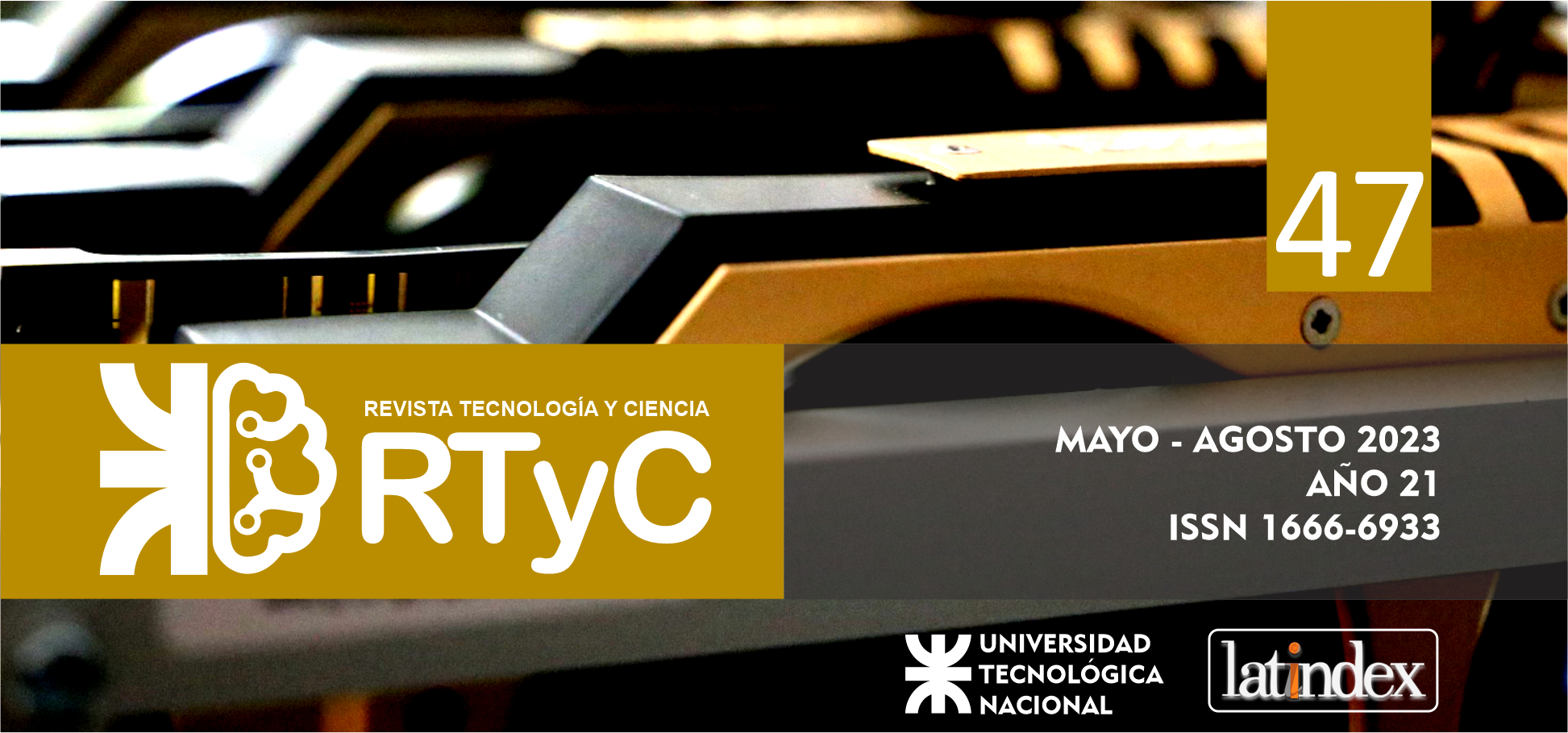Alternative Stochastic Modeling to Lotka-Volterra through a Multiagent System
DOI:
https://doi.org/10.33414/rtyc.47.35-46.2023Keywords:
Stochastic Modeling, Prey-Predator, Lotka-Volterra, Multiagent SystemAbstract
In this work, the modeling of a simple ecosystem of prey and predators is presented, through a multi-agent system where each individual of a species is characterized as a circle of a certain radius and mass that moves with a constant speed in a finite plane universe. The interactions between agents are characterized by the overlapping of areas of each agent during their displacements. This model not only allows adjusting conditions that show a coupled oscillatory temporal evolution of the populations, typical of the different solutions to the Lotka-Volterra equation, but also generates monitoring of variables of ecosystem interest such as the spatial distribution of agents or the density of biomass.
Downloads
References
Barbosa, P. y Castellanos, I. (2005). “Ecology of Predator-Prey Interactions”. Nueva York: Oxford University Press, ISBN: 0195171209,9780195171204.
Beauchamp, DA., Whal, DH y Johnson, BM. (2007). “Predator–prey interactions”. Nueva York: American Fisheries Society, 765–842.
Blanchard, J. L., Heneghan R. F., Everett J. D., Trebilco R., y Richardson A. J. (2017). “From Bacteria to Whales: Using Functional Size Spectra to Model Marine Ecosystems”, Trends in Ecology & Evolution, 32, 174-186, ISSN 0169-5347, (2017). Disponible en < https://www.sciencedirect.com/science/article/pii/S0169534716302361>.
Bunin, G. (2017). “Ecological communities with Lotka-Volterra dynamics”. Physical Review E, 95, 042414, (2017). Disponible en < https://link.aps.org/doi/10.1103/PhysRevE.95.042414>.
Cáceres, M. (2002) “Elementos de estadística de no equilibrio y sus aplicaciones al transporte en medios desordenados”. Editorial Reverté. ISBN 978-84-291-5031-5
Dattner, I., Miller, E., Petrenko, M., Kadouri, D. E., Jurkevitch, E., y Huppert A. (2017). “Modelling and parameter inference of predator–prey dynamics in heterogeneous environments using the direct integral approach”, Journal of The Royal Society Interface, 14 (126), 20160525, (2017). Disponible en < http://doi.org/10.1098/rsif.2016.0525>.
Fjeld, R., Eisenberg, N., Compton, K (2007). “Quantitative environmental risk analysis for human” John Wiley & Sons, Inc., Hoboken, New Jersey. ISBN-13: 978-0-471-72243-4. ISBN-10: 0-471-72243-X
Granda Velepucha, S., González Carrasco, V, López Bravo, M. (2016). "Principios de la Ecología General". Universidad técnica de Machala - Ecuador. Ediciones Utmach. ISBN: 978-9978-316-95-5.
Gilbert, N. y Terna, P. (2000)."How to build and use agent-based models in social science". Mind and Society 1(1), pp. 57-72.
Hatton, I. A., Mccann, K. S., Fryxell, J. M., Davies, T. J., Smerlak, M., Sinclair, A. R. E., y Loreau, M. (2015). “The predator-prey power law: Biomass scaling across terrestrial and aquatic biomes”, Science, 349 (6252), aac6284.
Jiang, D., Zhang, Q., Hayat, T., y Alsaedi A. (2017). “Periodic solution for a stochastic non-autonomous competitive Lotka–Volterra model in a polluted environment” Physica A. Statistical Mechanics and its Applications, 471, 276-287.
Lotka, A. J. (1910). “Contribution to the Theory of Periodic Reactions”. The Journal of Physical Chemistry, 14 (3), 271-274.
Odum E. P. and Barrett G. W. (1953) “Fundamentals of Ecology”, This particular set of data came from scanning in the graph from Odum’s “Fundamentals of Ecology”, Chapter 6: Population ecology, Section 5: Population Fluctuations and Cyclic Oscillations, pg 249. https://archive.org/details/fundamentals-of-ecology-odum/page/248/mode/2up?view=theater.
And were found in the course: “Introduction to Mathematical Modeling” http://people.whitman.edu/~hundledr/courses/M250F03/M250.html.
Papoulis, A (1991) “Probability, random variables, and stochastic processes” 3er edición. ISBN 0-07-048477-5
Perkon, L (1991)" Diferential Equations and Dynarnical Systems" Springer.
Peterson, R. O. y J. A. Vucetich. (2022). Ecological Studies of Wolves on Isle Royale, Annual Report 2021–2022. School of Forestry and Wood Products, Michigan Technological University. Houghton, Michigan.
Portalier, S. M. J., Fussmann, G. F., Loreau, M. y Cherif M. (2019). “The mechanics of predator–prey interactions: First principles of physics predict predator–prey size ratios”, Functional Ecology 33, 323-334, (2019). Disponible en <https://besjournals.onlinelibrary.wiley.com/doi/pdf/10.1111/1365-2435.13254>.
Seitbekova, Y., y Bakibayev, T. (2018). “Predator-Prey Interaction Multi-Agent Modelling”, International Conference on Application of Information and Communication Technologies, AICT 2018, Almaty, Kazakhstan, 17 al 19 de octubre, 1-5.
Skvortsov, A., Ristic, B., y A. Kamenev (2018). “Predicting population extinction from early observations of the Lotka–Volterra system”, Applied Mathematics and Computation, 320, 371-379.
Spiegel, M y Stephens, L (2009) “Estadística” 4ta edición. McGRAW-HILL/INTERAMERICANA EDITORES, S.A. ISBN-13: 978-970-10-6887-8. ISBN-10: 970-10-6887-8 (ISBN 970-10-3271-3 anterior)
Strogatz S. H. (2018). “Nonlinear Dynamics And Chaos With Applications To Physics, Biology, Chemistry, And Engineering”. Boca Ratón: CRC Press Taylor & Francis Group, ISBN 13: 978-0-8133-4910-7.
T. Johannessen (2014). “From an Antagonistic to a Synergistic Predator Prey Perspective. Bifurcations in Marine Ecosystem”. Cambridge: Academic Press. ISBN: 978-0-12-417016-2.
Uchmanski, J (1987)."Resourse partitionig amoung unequal competitors". Ekol.pol. 35. 71-87
Ulanowicz R. E. (1986). “Growth and Development: Ecosystems Phenomenology”. New York, Springer-Verlag New York ISBN-13: 978-1-4612-9359-0.
Published
How to Cite
Issue
Section
License
Copyright (c) 2023 Natalia Carolina Bustos, Claudia M. Sánchez, Daniel Horacio Brusa, Miguel Angel Ré, Javier Britch

This work is licensed under a Creative Commons Attribution-NonCommercial 4.0 International License.

















